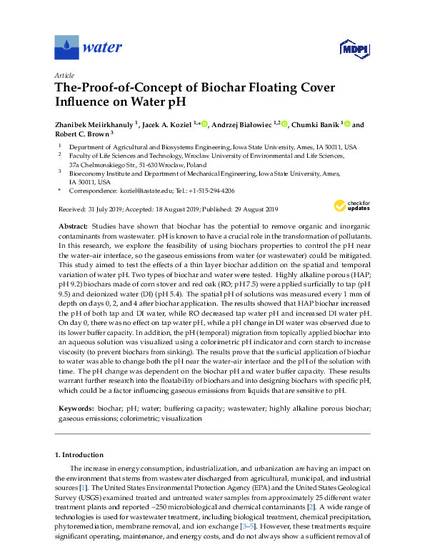
Studies have shown that biochar has the potential to remove organic and inorganic contaminants from wastewater. pH is known to have a crucial role in the transformation of pollutants. In this research, we explore the feasibility of using biochars properties to control the pH near the water–air interface, so the gaseous emissions from water (or wastewater) could be mitigated. This study aimed to test the effects of a thin layer biochar addition on the spatial and temporal variation of water pH. Two types of biochar and water were tested. Highly alkaline porous (HAP; pH 9.2) biochars made of corn stover and red oak (RO; pH 7.5) were applied surficially to tap (pH 9.5) and deionized water (DI) (pH 5.4). The spatial pH of solutions was measured every 1 mm of depth on days 0, 2, and 4 after biochar application. The results showed that HAP biochar increased the pH of both tap and DI water, while RO decreased tap water pH and increased DI water pH. On day 0, there was no effect on tap water pH, while a pH change in DI water was observed due to its lower buffer capacity. In addition, the pH (temporal) migration from topically applied biochar into an aqueous solution was visualized using a colorimetric pH indicator and corn starch to increase viscosity (to prevent biochars from sinking). The results prove that the surficial application of biochar to water was able to change both the pH near the water–air interface and the pH of the solution with time. The pH change was dependent on the biochar pH and water buffer capacity. These results warrant further research into the floatability of biochars and into designing biochars with specific pH, which could be a factor influencing gaseous emissions from liquids that are sensitive to pH.
Available at: http://works.bepress.com/jacek_koziel/280/

This article is published as Meiirkhanuly, Zhanibek, Jacek A. Koziel, Andrzej Białowiec, Chumki Banik, and Robert C. Brown. "The-Proof-of-Concept of Biochar Floating Cover Influence on Water pH." Water 11, no. 9 (2019): 1802. DOI: 10.3390/w11091802. Posted with permission.